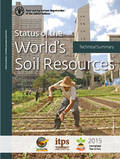Documents
Global Soil Organic Carbon Map - Leaflet
The Global Soil Partnership (GSP) and the Intergovernmental Technical Panel on Soils (ITPS) launched a global endeavor to develop the Global Soil Organic Carbon map (GSOCmap) using a country-driven approach as part of the Global Soil Information System (GLOSIS).
Proceedings of the Global Symposium on Soil Organic Carbon 2017
The Proceedings of the Global Symposium on Soil Organic Carbon 2017 (GSOC17) presents the abstracts of all scientific presentations held during the GSOC17. 103 oral presentations and 35 poster presentations built the core of this event triggering fruitful discussions on the state-of-science in measuring, preserving and enhancing soil organic carbon in different soils of the world.
Unlocking the Potential of Soil Organic Carbon – Outcome Document of the Global Symposium on Soil Organic Carbon
The overall aim of the symposium was to review the role of soils and SOC in the context of climate change, sustainable development and land degradation neutrality (LDN). The three-day symposium was structured around three main themes focusing on the assessment of SOC, the maintenance and increase of SOC stocks, and SOC management in specific types of soil.
Soil Organic Carbon: the hidden potential
The publication was launched at the Global Symposium on Soil Organic Carbon (GSOC) held at FAO headquarters (Rome, 21-23 March 2017). It provides an overview to decision-makers and practitioners of the main scientific facts and information regarding the current knowledge and knowledge gaps on Soil Organic Carbon. It highlights how better information and good practices may be implemented to support ending hunger, adapting to and mitigating climate change and achieving overall sustainable development.
Concept note and agenda
In the presence of climate change, land degradation and biodiversity loss, soils have become one of the most vulnerable resources in the world.1 Notwithstanding the enormous scientifc progress made to date, protection and monitoring of soil resources at national and global levels still face complicated challenges impeding effective on-the-ground policy design and implementation that varies widely from region to region. There is still insuffcient global support for the protection and sustainable management of the world’s soil resources.
Status of the World's Soil Resources
Main report
The SWSR is a reference document on the status of global soil resources that provides regional assessments of soil change. The information is based on peer-reviewed scientific literature, complemented with expert knowledge and project outputs. It provides a description and a ranking of ten major soil threats that endanger ecosystem functions, goods and services globally and in each region separately.
Status of the World's Soil Resources
Technical Summary
This document presents a summary of the first Status of the World’s Soil Resources report, the goal of which is to make clear the essential connections between human well-being and the soil. The report provides a benchmark against which our collective progress to conserve this essential resource can be measured. The report synthesizes the work of some 200 soil scientists from 60 countries.
World Soil Charter
The first World Soil Charter (WSC) was conceived and formulated, negotiated and adopted by the FAO member countries in the 1981 FAO Conference. It was a major normative instrument agreed by member states, and that the Global Soil Partnership (GSP) was duty-bound to promote its principles. The challenges faced by the world have become more evident and severe in the intervening three decades.
Добровольные руководящие принципы рационального использования почвенных ресурсов
Настоящие Добровольные принципы были приняты 4-ой сессией Пленарной ассамблеи ГПП (Рим, 25 мая 2016 года), одобрены 25-ой сессией Комитета ФАО по сельскому хозяйству (Рим, 28 сентября 2016 года) и окончательно утверждены 155-ой сессией Совета ФАО (Рим, 5 декабря 2016 года).
Настоящие “Добровольные руководящие принципы рационального использования почвенных ресурсов” (ДРПРИПР) были выработаны в ходе подразумевающего широкое участие процесса в рамках Глобального почвенного партнерства (ГПП). Они должны стать справочным документом, содержащим общие технические и политические рекомендации в области рационального использования почвенных ресурсов (РИПР) для широкого круга приверженных своему делу заинтересованных сторон.
Can Carbon (SOC) offset the climate change?
The relationship between climate change and soil carbon resources is of key concern to human society.










